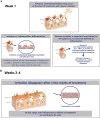Why Topical Retinoids Are Mainstay of Therapy for Acne
- PMID: 28585191
- PMCID: PMC5574737
- DOI: 10.1007/s13555-017-0185-2
Why Topical Retinoids Are Mainstay of Therapy for Acne
Abstract
Acne-focused dermatology expert groups have consistently recommended that most patients with acne be treated with a combination of topical retinoid and antimicrobial therapy. This is based on clinical data as well as evidence that these drug classes have different and complementary mechanisms of action that target multiple aspects of acne's complex pathophysiology. Recent evidence-based guidelines for acne, including those from the American Academy of Dermatology (AAD) and the European Dermatology Forum (EDF), have agreed that retinoids have an essential role in this widespread disease. The AAD states "retinoids are the core of topical therapy for acne because they are comedolytic, resolve the precursor microcomedone lesion, and are anti-inflammatory;" further, they "allow for maintenance of clearance." Despite uniform recommendation for use of topical retinoids, a recent study of prescribing practices from 2012 to 2014 indicated that dermatologists prescribed retinoids just 58.8% of the time while non-dermatologists prescribed them for only 32.4% of cases. In this article, we review the reasons supporting retinoids as the mainstay of acne therapy and discuss some of the perceived barriers that may be limiting use of this important drug class. Further, we discuss how and when titrating retinoid concentrations may be utilized in clinical practice.
Funding: Galderma International.
Keywords: Acne vulgaris; Adapalene; Tazarotene; Topical retinoid; Tretinoin.
Figures




Similar articles
-
Topical Retinoids in Acne Vulgaris: A Systematic Review.Am J Clin Dermatol. 2019 Jun;20(3):345-365. doi: 10.1007/s40257-019-00423-z. Am J Clin Dermatol. 2019. PMID: 30674002
-
Topical retinoids in acne vulgaris: update on efficacy and safety.Am J Clin Dermatol. 2008;9(6):369-81. doi: 10.2165/0128071-200809060-00003. Am J Clin Dermatol. 2008. PMID: 18973403 Review.
-
Targeted Topical Delivery of Retinoids in the Management of Acne Vulgaris: Current Formulations and Novel Delivery Systems.Pharmaceutics. 2019 Sep 24;11(10):490. doi: 10.3390/pharmaceutics11100490. Pharmaceutics. 2019. PMID: 31554188 Free PMC article. Review.
-
Topical retinoids in inflammatory acne: a retrospective, investigator-blinded, vehicle-controlled, photographic assessment.Clin Ther. 2005 Feb;27(2):216-24. doi: 10.1016/j.clinthera.2005.02.009. Clin Ther. 2005. PMID: 15811485
-
Expert committee recommendations for acne management.Pediatrics. 2006 Sep;118(3):1188-99. doi: 10.1542/peds.2005-2022. Pediatrics. 2006. PMID: 16951015 Review.
Cited by
-
50 Years of Topical Retinoids for Acne: Evolution of Treatment.Am J Clin Dermatol. 2021 May;22(3):315-327. doi: 10.1007/s40257-021-00594-8. Am J Clin Dermatol. 2021. PMID: 33871811 Review.
-
Efficacy and Safety of a Fixed-Dose Clindamycin Phosphate 1.2%, Benzoyl Peroxide 3.1%, and Adapalene 0.15% Gel for Moderate-to-Severe Acne: A Randomized Phase II Study of the First Triple-Combination Drug.Am J Clin Dermatol. 2022 Jan;23(1):93-104. doi: 10.1007/s40257-021-00650-3. Epub 2021 Oct 21. Am J Clin Dermatol. 2022. PMID: 34674160 Free PMC article. Clinical Trial.
-
Polycystic ovary syndrome: definition, aetiology, diagnosis and treatment.Nat Rev Endocrinol. 2018 May;14(5):270-284. doi: 10.1038/nrendo.2018.24. Epub 2018 Mar 23. Nat Rev Endocrinol. 2018. PMID: 29569621 Review.
-
Endocrine Disrupting Chemicals, Hormone Receptors, and Acne Vulgaris: A Connecting Hypothesis.Cells. 2021 Jun 9;10(6):1439. doi: 10.3390/cells10061439. Cells. 2021. PMID: 34207527 Free PMC article. Review.
-
Dermatologic Conditions in Transgender Populations.Endocrinol Metab Clin North Am. 2019 Jun;48(2):429-440. doi: 10.1016/j.ecl.2019.01.005. Endocrinol Metab Clin North Am. 2019. PMID: 31027550 Free PMC article. Review.
References
Publication types
LinkOut - more resources
Full Text Sources
Other Literature Sources

